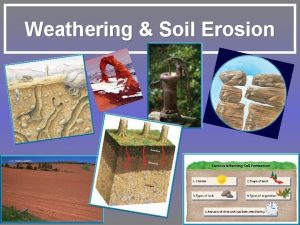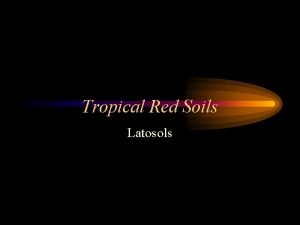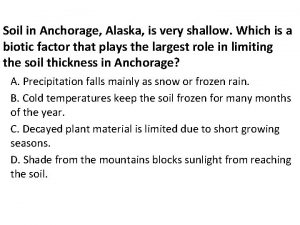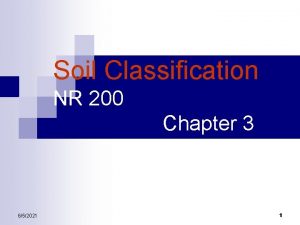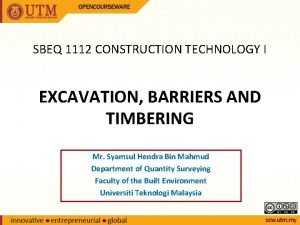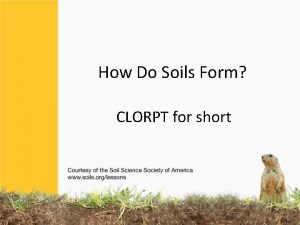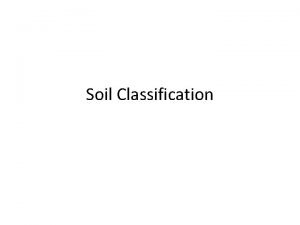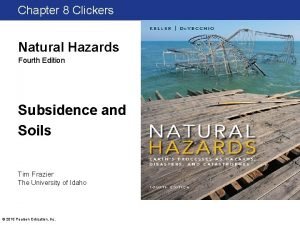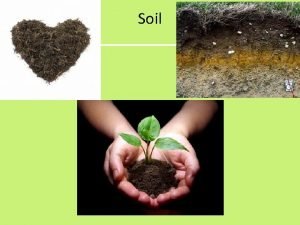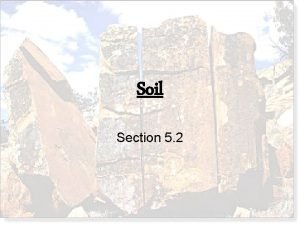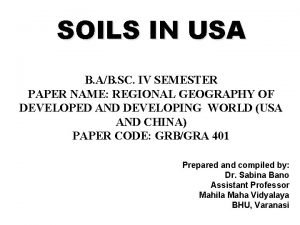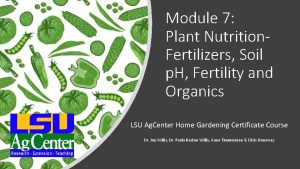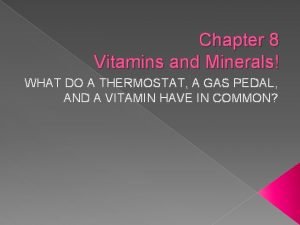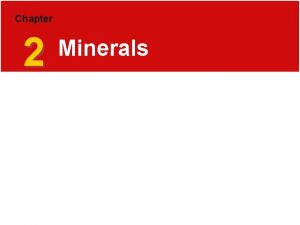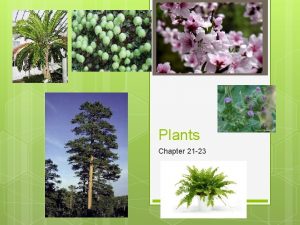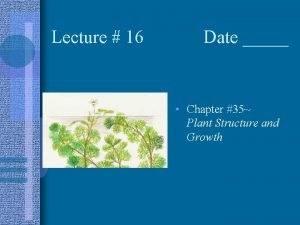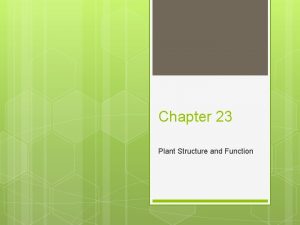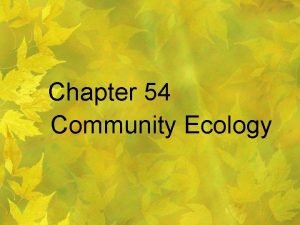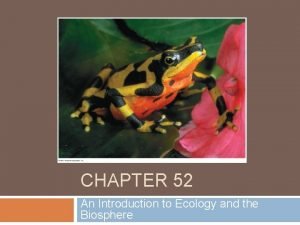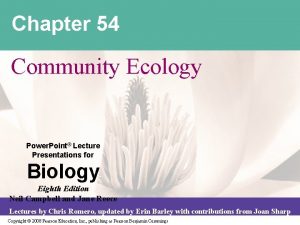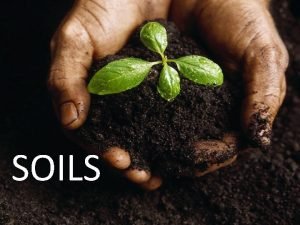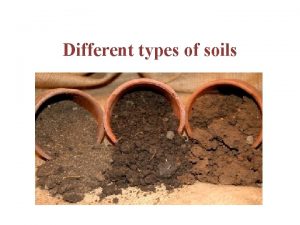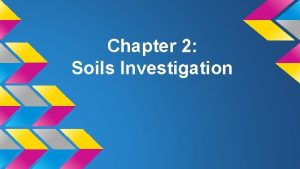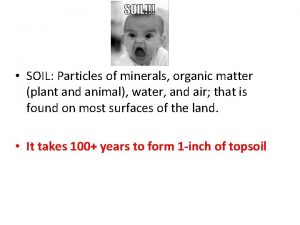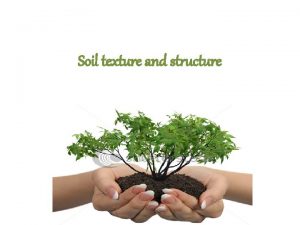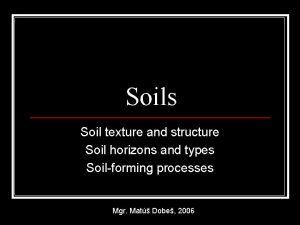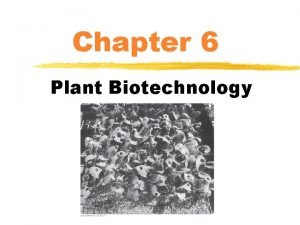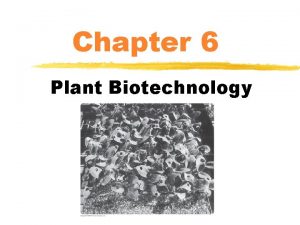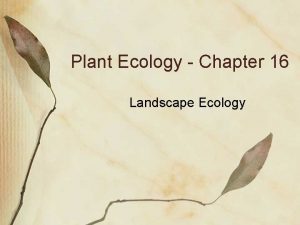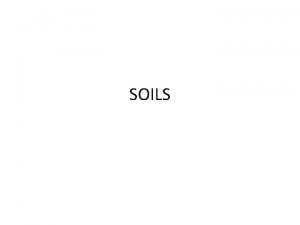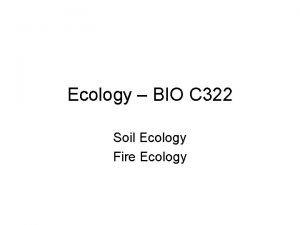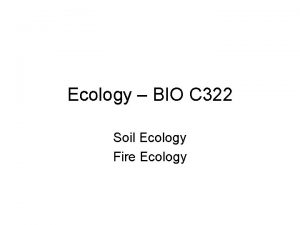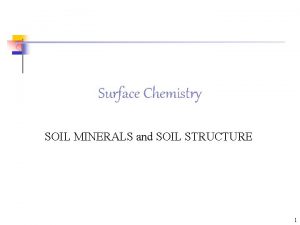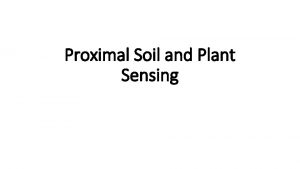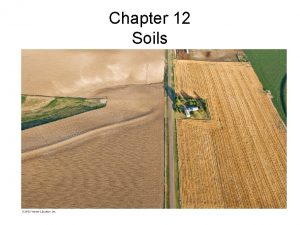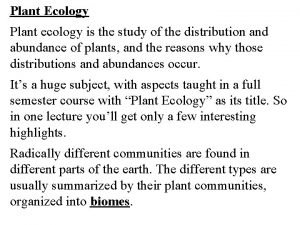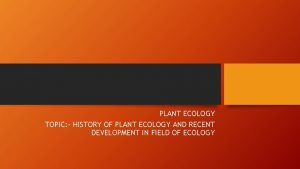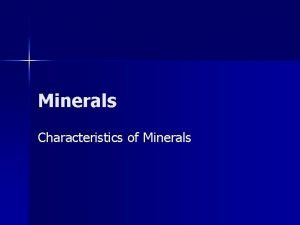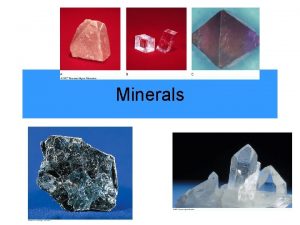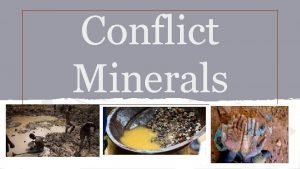Plant Ecology Chapter 4 Soils Minerals Soil Structure

















































- Slides: 49

Plant Ecology - Chapter 4 Soils & Minerals

Soil Structure & Texture Soil structure physical arrangement of soil particles into aggregates Controls soil porosity

Soil Structure & Texture Soil texture proportional distribution of different-sized particles

Soil Structure & Texture

Soil Structure & Texture Loam soils have balance between sand, silt, clay Equal parts of sand silt, less clay Generally most desirable for agriculture

Soil Structure & Texture Sandy soils - >50% sand particles coarse texture Hold water, minerals poorly Warm quickly, cool quickly

Soil Structure & Texture Clayey soils - >35% clay Hold large volume of water Retain water and minerals well Also retain pesticides, pollutants

Soil Structure & Texture Poor infiltration = greater runoff Poor drainage, poor aeration Slow to warm and cool

Soil Structure & Texture Silty soils - >50% silt Intermediate in characteristics between sandy and clayey soils

Soil Structure & Texture Sand, silt particles irregular in shape Clay particles platelike or rod-shaped Clay particles have large surface-tovolume ratio

Soil Structure & Texture Particle size, shape affects porosity Pore space in sandy soils - 35 -50% Clayey soils - 5060% - smaller particle size & arrangement (cluster together)

Soil Structure & Texture Clay particles usually bear strong negative electrochemical charge Attract cations, such as important nutrients and water molecules

Soil Structure & Texture H, Ca, Mg, K, Na ions most abundant in soils in humid regions Arid soils, H ions move to last on list, Na more important All attract, hold water molecules

Soil Structure & Texture Cations attracted to clay particles partially available to plants Exchange between particles, soil water Ions can be taken up by plants from water, leached, or reattach to other particles

Soil p. H in U. S. - 3. 5 to 10 Native vegetation adapted to all p. Hs, but most ag crops grow best in slightly acidic soils Changing p. H has strong effects on nutrient and toxin availability, soil biota (bacteria, fungi)

Soil p. H Forest trees especially tolerant of acidic soils Conifers tend to increase acidity of soil (lower p. H) via decomposition of needles

Soil p. H Grasslands tend to grow on alkaline soils Low rainfall results in soils with high p. H

Soil Horizons & Profiles Soils contain layers horizons Sequence of horizons produces a soil profile O, A, B, C, R

Soil Horizons & Profiles O horizon - organic matter

Soil Horizons & Profiles A horizon - topsoil Region of maximum leaching - eluviation

Soil Horizons & Profiles B horizon - subsoil Region of maximum deposition illuviation

Soil Horizons & Profiles C horizon undeveloped mineral material

Soil Horizons & Profiles R horizon - parent material (bedrock)

Soil Development Residual soils develop in place by breakdown of bedrock Ecological succession 100 s to 1000 s of years

Soil Development Transported soils carried from some other place - wind, water, glaciers

Soil Development 5 factors determine the kinds of soils that develop in an area Climate, parent material, time, topography, living organisms

Soil order

Organic Matter, Organisms Organic matter humus - contributes, binds nutrients, retains water, acidifies soil (alters nutrient availability) Organism actions alter porosity, structure

Water in Soils

Water in Soils

Water in Soils

Water in Soils

Water in Soils Hydraulic lift - deeprooted plants pull water upward Moves out into drier, shallow soils Allows survival of shallow-rooted plants during drought, or in arid environments

Plant Nutrients Macronutrients and micronutrients Essential vs. beneficial Two most important for plants: nitrogen and phosphorus


Nitrogen Fixers Free-living nitrogen fixers cyanobacteria Flooded rice paddies, some surface soils

Nitrogen Fixers Symbiotic nitrogen fixers Rhizobium, Bradyrhizobium on legumes - root nodules Frankia on non-legumes Cyanobacteria external to some plant roots loose associations


Phosphorus in Soils Availability not directly related to amount present in soil Phosphorus bound in ways that make it unavailable to plants Bound to clay particles, metal ions, immobilized by microbes

Evergreen vs. Deciduous Evergreens often characteristic of nutrient -poor soils, soils subject to drought Deciduous leaves require higher investments in photosynthetic enzymes, other proteins

Mycorrhizae Symbioses between various fungi, roots of terrestrial plants Extremely common, widespread Approach for dealing with phosphorus limitation, other nutrient shortages

Mycorrhizae Two major groups Endomycorrhizae Ectomycorrhizae Endo- are most common, especially arbuscular mycorrhizae

Mycorrhizae Arbuscular mycorrhizae - most abundant where phosphorus is limited, in warm, dry climates Important in tropical ecosystems, and for crop pants - woody and herbaceous Fungal body grows inside root cells, with hyphae extending outward

Mycorrhizae Arbuscular mycorrhizae associations not highly specific same fungus may have many plant host species, or one host may have several fungal associates

Mycorrhizae Ectomycorrhizae woody plants, especially temperate conifers Hartig net between root cells, mantle network of hyphae outside root

Mycorrhizae Fungal hyphae increase nutrient uptake from soil Transfer nutrients to root cells of host plants

Mycorrhizae Increased uptake, especially of phosphorus, results from higher surface area, and production of enzymes that release phosphorus from clay

Mycorrhizae - more good Improve metal uptake Improve water uptake Break down soil proteins Protect roots from toxins Protect plant from fungal, bacterial diseases

Mutualism or Parasitism? Fungi get carbon, energy from plant host Plant gets nutrients, other benefits Either “partner” can function as parasite at times - plant sheds fungus when times are good, or fungus gives little to plant
 Minerals in the soil
Minerals in the soil Living soil vs dead soil
Living soil vs dead soil Four major spheres of the earth
Four major spheres of the earth The rate of weathering depends upon the area's ____.
The rate of weathering depends upon the area's ____. Latosol soil profile
Latosol soil profile Soil
Soil Anchorage soil
Anchorage soil Aridisols are soils characteristically found in _______.
Aridisols are soils characteristically found in _______. Timbering in loose soil
Timbering in loose soil Clorpt
Clorpt What is soil
What is soil How does the study of soils help evaluate natural hazards?
How does the study of soils help evaluate natural hazards? 4 components of soil
4 components of soil Which is not true of laterite soils
Which is not true of laterite soils Soil layers
Soil layers Ashley soils
Ashley soils Pedalfer soil
Pedalfer soil Chapter 4 population ecology test answer key
Chapter 4 population ecology test answer key Plant nutrition and soil science
Plant nutrition and soil science Chapter 8 vitamins and minerals
Chapter 8 vitamins and minerals Chapter 2 minerals
Chapter 2 minerals Chapter 22 plant structure and function answer key
Chapter 22 plant structure and function answer key Chapter 21 plant structure and function
Chapter 21 plant structure and function Chapter 35 plant structure growth and development
Chapter 35 plant structure growth and development Primary growth and secondary growth in plants
Primary growth and secondary growth in plants Chapter 23 plant structure and function
Chapter 23 plant structure and function Plant introduction
Plant introduction Plant breeding for disease resistance
Plant breeding for disease resistance Plant introduction in plant breeding
Plant introduction in plant breeding Tronsmo plant pathology and plant diseases download
Tronsmo plant pathology and plant diseases download Tronsmo plant pathology and plant diseases download
Tronsmo plant pathology and plant diseases download Albugo eye
Albugo eye Chapter 52: an introduction to ecology and the biosphere
Chapter 52: an introduction to ecology and the biosphere Section 1 community ecology
Section 1 community ecology Chapter 56 conservation biology and restoration ecology
Chapter 56 conservation biology and restoration ecology Phosphorus cycle pearson education
Phosphorus cycle pearson education Chapter 54: community ecology answer key
Chapter 54: community ecology answer key Chapter 53 population ecology
Chapter 53 population ecology Chaparral climograph
Chaparral climograph Chapter 5 evolution and community ecology answer key
Chapter 5 evolution and community ecology answer key Chapter 36 population ecology
Chapter 36 population ecology Principles of ecology section 2 flow of energy
Principles of ecology section 2 flow of energy Principles of ecology chapter 2
Principles of ecology chapter 2 Chapter 2 principles of ecology answers
Chapter 2 principles of ecology answers Chapter 4 population ecology answer key
Chapter 4 population ecology answer key Chapter 54 community ecology
Chapter 54 community ecology Chapter 53 population ecology
Chapter 53 population ecology Chapter 55 ecosystems and restoration ecology
Chapter 55 ecosystems and restoration ecology Chapter 5 evolution and community ecology
Chapter 5 evolution and community ecology Chapter 5 evolution and community ecology
Chapter 5 evolution and community ecology



